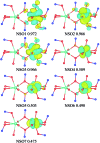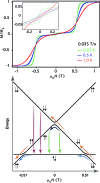Assessing the exchange coupling in binuclear lanthanide(iii) complexes and the slow relaxation of the magnetization in the antiferromagnetically coupled Dy2 derivative
- PMID: 29218180
- PMCID: PMC5707489
- DOI: 10.1039/c5sc01029b
Assessing the exchange coupling in binuclear lanthanide(iii) complexes and the slow relaxation of the magnetization in the antiferromagnetically coupled Dy2 derivative
Erratum in
-
Correction: Assessing the exchange coupling in binuclear lanthanide(iii) complexes and the slow relaxation of the magnetization in the antiferromagnetically coupled Dy2 derivative.Chem Sci. 2015 Aug 1;6(8):5087. doi: 10.1039/c5sc90037a. Epub 2015 Jun 26. Chem Sci. 2015. PMID: 30210759 Free PMC article.
Abstract
We report here the synthesis and the investigation of the magnetic properties of a series of binuclear lanthanide complexes belonging to the metallacrown family. The isostructural complexes have a core structure with the general formula [Ga4Ln2(shi3-)4(Hshi2-)2(H2shi-)2(C5H5N)4(CH3OH) x (H2O) x ]·xC5H5N·xCH3OH·xH2O (where H3shi = salicylhydroxamic acid and Ln = GdIII1; TbIII2; DyIII3; ErIII4; YIII5; YIII0.9DyIII0.16). Apart from the Er-containing complex, all complexes exhibit an antiferromagnetic exchange coupling leading to a diamagnetic ground state. Magnetic studies, below 2 K, on a single crystal of 3 using a micro-squid array reveal an opening of the magnetic hysteresis cycle at zero field. The dynamic susceptibility studies of 3 and of the diluted DyY 6 complexes reveal the presence of two relaxation processes for 3 that are due to the excited ferromagnetic state and to the uncoupled DyIII ions. The antiferromagnetic coupling in 3 was shown to be mainly due to an exchange mechanism, which accounts for about 2/3 of the energy gap between the antiferro- and the ferromagnetic states. The overlap integrals between the Natural Spin Orbitals (NSOs) of the mononuclear fragments, which are related to the magnitude of the antiferromagnetic exchange, are one order of magnitude larger for the Dy2 than for the Er2 complex.
Figures










References
-
- Sessoli R., Tsai H., Schake A. R., Wang S., Vincent J. B., Folting K., Gatteschi D., Christou G., Hendrickson D. N. J. Am. Chem. Soc. 1993;115:1804.
-
- Bogani L., Wernsdorfer W. Nat. Mater. 2008;7:179. - PubMed
-
- Winpenny R. E. P. Angew. Chem., Int. Ed. 2008;47:7992. - PubMed
-
- Zaleski C. M., Depperman E. C., Dendrinou-Samara C., Alexiou M., Kampf J. W., Kessissoglou D. P., Kirk M. L., Pecoraro V. L. J. Am. Chem. Soc. 2005;127:12862. - PubMed
-
- Ako A. M., Hewitt I. J., Mereacre V., Clérac R., Wernsdorfer W., Anson C. E., Powell A. K., Christou G., Gatteschi D., Hendrickson D. N., Sessoli R., Barra A. L., Caneschi A., Cornia A., Fabrizi de Biani F., Gatteschi D., Sangregorio C., Sessoli R., Sorace L. Angew. Chem., Int. Ed. MRS Bull. J. Am. Chem. Soc. 2006;2000;1999;4525121:4926. 66, 5302. - PubMed
LinkOut - more resources
Full Text Sources
Other Literature Sources
Miscellaneous

